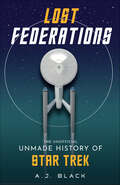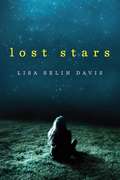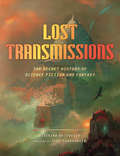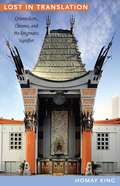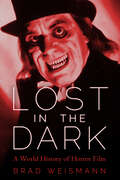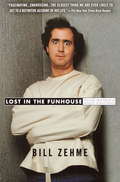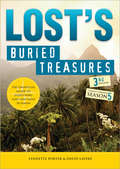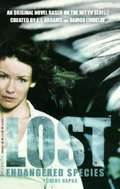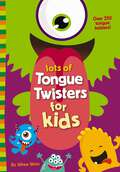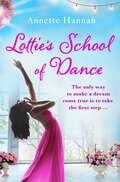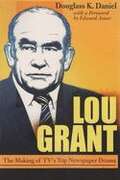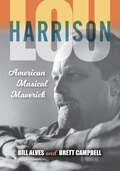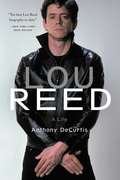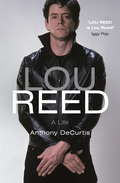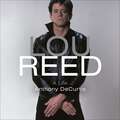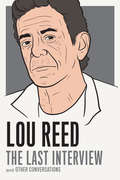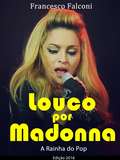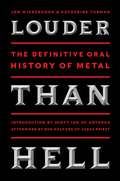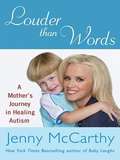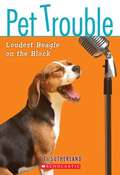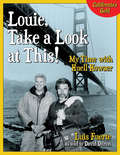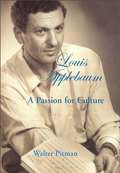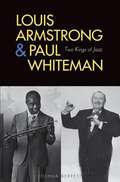- Table View
- List View
Lost Federations: The Unofficial Unmade History of Star Trek
by A. J. Black"An innovative and unusual account of Star Trek’s lost voyages that makes for a fascinating alternate history." — Brian J. Robb in Sci-Fi Bulletin SPACE. THE FINAL FRONTIER. THESE WERE ALMOST THE VOYAGES OF THE STARSHIP ENTERPRISE. We think we know the history of Star Trek. Born at the height of 1960s popular culture, the five-year mission of Captain James T. Kirk and his crew faced early cancellation, bounced back with a series of beloved movies in the 1980s and gave way to a fleet of successful sequels and spin-offs that kept on exploring strange new worlds. In Lost Federations: The Unofficial Unmade History of Star Trek, author A. J. Black tells a different story. This is an alternate history of the franchise, one filled with roads not taken, from early 1960s feature-films and spin-offs, the original sequel Star Trek: Phase II in the 1970s, via epic planned movies such as Planet of the Titans and into many untold episodes, arcs and character stories from The Next Generation, Deep Space Nine and Voyager, all the way through to the modern era. Bringing together pre-existing material over decades for the first time in one space, plus some new reflections from Star Trek writers and analysis of how it all fits into the wider cultural trends of the last sixty years, Lost Federations invites you to boldly explore a history you may not already know...
Lost Stars (A Broken Code #1)
by Lisa Selin DavisEleanor & Park meets Perks of Being a Wallflower in this bittersweet 1980’s story about love, loss, and a comet that only comes around every ninety-seven years. When Carrie looks through her telescope, the world makes sense. It’s life here on Earth that’s hard to decipher. Since her older sister, Ginny, died, Carrie has been floating in the orbit of Ginny’s friends, the cool kids, who are far more interested in bands and partying than science. Carrie’s reckless behavior crosses a line, and her father enrolls her in a summer work camp at a local state park. There, Carrie pulls weeds and endures pep talks about the power of hard work. Despite her best efforts to hate the job, Carrie actually feels happy out in nature. And when she meets Dean—warm, thoughtful, and perceptive—she starts to discover that her life can be like her beloved night sky, with black holes of grief for Ginny and dazzling meteors of joy from first love.
Lost Transmissions: The Secret History of Science Fiction and Fantasy
by Desirina BoskovichThis illustrated journey through lost, overlooked, and uncompleted works is &“a fascinating enrichment of the history of sf and fantasy&” (Booklist). Science fiction and fantasy reign over popular culture now, associated in our mind with blockbuster movies and massive conventions. But there&’s much more to the story than the headline-making hits. Lost Transmissions is a rich trove of forgotten and unknown, imagined-but-never-finished, and under-appreciated-but-influential works from those imaginative genres, as well as little-known information about well-known properties. Divided into sections on Film & TV, Literature, Art, Music, Fashion, Architecture, and Pop Culture, the book examines: Jules Verne&’s lost novelAfroFuturism and Space DiscoE.T.&’s scary beginningsWilliam Gibson&’s never-filmed Aliens sequelWeezer&’s never-made space operathe 8,000-page metaphysical diary of Philip K. Dick, and more Featuring more than 150 photos, this insightful volume will become the bible of science fiction and fantasy&’s most interesting and least-known chapters. &“Will broaden your horizons and turn you on to wonders bubbling under the mass-market commodified pleasures to which we all too often limit ourselves.&” —The Washington Post
Lost in Translation: Orientalism, Cinema, and the Enigmatic Signifier
by Homay KingIn a nuanced exploration of how Western cinema has represented East Asia as a space of radical indecipherability, Homay King traces the long-standing association of the Orient with the enigmatic. The fantasy of an inscrutable East, she argues, is not merely a side note to film history, but rather a kernel of otherness that has shaped Hollywood cinema at its core. Through close readings of The Lady from Shanghai, Chinatown, Blade Runner, Lost in Translation, and other films, she develops a theory of the "Shanghai gesture," a trope whereby orientalist curios and dcor become saturated with mystery. These objects and signs come to bear the burden of explanation for riddles that escape the Western protagonist or cannot be otherwise resolved by the plot. Turning to visual texts from outside Hollywood which actively grapple with the association of the East and the unintelligible--such as Michelangelo Antonioni's Chung Kuo: Cina, Wim Wenders's Notebook on Cities and Clothes, and Sophie Calle's Exquisite Pain--King suggests alternatives to the paranoid logic of the Shanghai gesture. She argues for the development of a process of cultural "de-translation" aimed at both untangling the psychic enigmas prompting the initial desire to separate the familiar from the foreign, and heightening attentiveness to the internal alterities underlying Western subjectivity.
Lost in the Dark: A World History of Horror Film
by Brad WeismannTwo horror films were nominated for the Academy Award for Best Picture in 2018, and one of them—The Shape of Water—won. Since 1990, the production of horror films has risen exponentially worldwide, and in 2013, horror films earned an estimated $400 million in ticket sales. Horror has long been the most popular film genre, and more horror movies have been made than any other kind. We need them. We need to be scared, to test ourselves, laugh inappropriately, scream, and flinch. We need to get through them and come out, blinking, still in one piece. Lost in the Dark: A World History of Horror Film is a straightforward history written for the general reader and student that can serve as a comprehensive reference work. The volume provides a general introduction to the genre, serves as a guidebook to its film highlights, and celebrates its practitioners, trends, and stories. Starting with silent-era horror films and ending with 2020’s The Invisible Man, Lost in the Dark looks at decades of horror movies. Author Brad Weismann covers such topics as the roots of horror in literature and art, monster movies, B-movies, the destruction of the American censorship system, international horror, torture porn, zombies, horror comedies, horror in the new millennium, and critical reception of modern horror. A sweeping survey that doesn’t scrimp on details, Lost in the Dark is sure to satisfy both the curious and the completist.
Lost in the Funhouse: The Life and Mind of Andy Kaufman
by Bill ZehmeFrom renowned journalist Bill Zehme, author of theNew York TimesbestsellingThe Way You Wear Your Hat: Frank Sinatra and the Lost Art of Livin', comes the first full-fledged biography and the only complete story of the late comic genius Andy Kaufman. Based on six years of research, Andy's own unpublished, never-before-seen writings, and hundreds of interviews with family members, friends, and key players in Andy's endless charades, many of whom have become icons in their own right,Lost in the Funhousetakes us through the maze of Kaufman's mind and lets us sit deep behind his mad, dazzling blue eyes to see, firsthand, the fanciful landscape that was his life. Controversial, chaotic, splendidly surreal, and tragically brief--what a life it was. Andy Kaufman was often a mystery even to his closest friends. Remote, aloof, impossible to know, his internal world was a kaleidoscope of characters fighting for time on the outside. He was as much Andy Kaufman as he was Foreign Man (dank you veddy much), who became the lovably bashful Latka on the hit TV seriesTaxi. He was as much Elvis Presley as he was the repugnant Tony Clifton, a lounge singer from Vegas who hated any audience that came to see him and who seemed to hate Andy Kaufman even more. He was a contradiction, a paradox on every level, an artist in every sense of the word. During the comic boom of the seventies, when the world had begun to discover the prodigious talents of Steve Martin, Richard Pryor, John Belushi, Bill Murray, and so many others, Andy was simply doing what he had always done in his boyhood reveries. On the debut ofSaturday Night Live,he stood nervously next to a phonograph that scratchily played the theme from Mighty Mouse. He fussed and fidgeted, waiting for his moment. When it came, he raised his hand and moved his mouth to the words "Here I come to save the day!" In that beautiful deliverance of pantomime before the millions of people for whom he had always dreamed about performing, Andy triumphed. He changed the face of comedy forever by lurching across boundaries that no one knew existed. He was the boy who made life his playground and never stopped playing, even when the games proved too dangerous for others. And in the end he would play alone, just as he had when it was all only beginning. InLost in the Funhouse, Bill Zehme sorts through a life of disinformation put forth by a master of deception to uncover the motivation behind the manipulation. Magically entertaining, it is a singular biography matched only by its singular subject.
Lost's Buried Treasures: The Unofficial Guide to Everything Lost Fans Need to Know
by Lynnette Porter David LaveryThe Ultimate Unauthorized Resource to the Stories Behind Lost Lost is a complex and mysterious tale, one that draws on many sources for its themes and ideas-sources you must understand to become an advanced Lost expert. Lost's Buried Treasures is the ultimate unauthorized guide to the ideas that have influenced the show and its writers-and is completely updated through Season Five. Explore: Books and movies important to the show and how they are connected Geographical clues New and old theories Musical references and the meaning behind the incredible soundtrack The best online resources The video and role-playing games and what they've revealed Cast, writer, and director biographies And much more NO TRUE LOST FAN SHOULD EVER WATCH AN EPISODE WITHOUT THIS CRUCIAL GUIDE IN HAND. Explore all the interconnected stories and mysterious references that make the show so fascinating. DISCLAIMER: This book is an independent work of commentary, criticism, and scholarship. Neither this book, nor its author and publisher, are authorized, endorsed or sponsored by, or affiliated in any way with the copyright and trademark owner of Lost and/or the creators of Lost.
Lost: Endangered Species
by Catherine HapkaLost, the television series, takes place on a remote South Pacific island, where a plane crash has left 48 survivors stranded. These novelizations focus on survivors who are not main characters on the television series, adding depth to the show, and also offering new and compelling stories and characters for Lost fans. These new characters have original adventures rooted within the show's continuity; they cross with characters from the show, and even take a background role in major events seen on the show.
Lots of Christmas Jokes for Kids
by Whee WinnChristmastime just got a whole lot merrier with Lots of Christmas Jokes for Kids. Over 250 hilarious, kid-friendly jokes and riddles will make the whole family laugh out loud!Q: Why is it always cold at Christmastime?A: Because Christmas is in Decembrrrr.Q: Who delivers Christmas presents to cats?A: Santa Claws!
Lots of Tongue Twisters for Kids
by Whee WinnGet ready to laugh out loud with Lots of Tongue Twisters for Kids, a collection of hilarious, kid-friendly fun. Over 250 tongue twisters will send kids and grown-ups alike into a fit of giggles! <P><P>How much wood would a woodchuck chuck if a woodchuck could chuck wood? <P><P>If two witches watch two watches, which witch would watch which watch?
Lottie's School of Dance
by Annette HannahLottie Daniels is dancing up the altar in Canada when she realises her whirlwind wedding is a big mistake. Chad isn't the right person for her at all! And, in that moment, Lottie goes from dancing bride to runaway bride.Much to her brother's relief, Lottie decides to return to Bramblewood in the UK. But life has more surprises in store for her. After rescuing both a donkey and a little old lady called Doris - all with the help of a handsome stranger! - Lottie suddenly becomes a big part of Doris's life. From broken dreams to second chances, Lottie finally has a chance to rebuild her life. When her friends suggest she takes part in a dance audition she refuses point blank but it soon becomes clear that destiny has other plans.You are guaranteed to fall head over heels with this sweet and charming romance.
Lottie's School of Dance
by Annette HannahLottie Daniels is dancing up the altar in Canada when she realises her whirlwind wedding is a big mistake. Chad isn't the right person for her at all! And, in that moment, Lottie goes from dancing bride to runaway bride.Much to her brother's relief, Lottie decides to return to Bramblewood in the UK. But life has more surprises in store for her. After rescuing both a donkey and a little old lady called Doris - all with the help of a handsome stranger! - Lottie suddenly becomes a big part of Doris's life. From broken dreams to second chances, Lottie finally has a chance to rebuild her life. When her friends suggest she takes part in a dance audition she refuses point blank but it soon becomes clear that destiny has other plans.You are guaranteed to fall head over heels with this sweet and charming romance.
Lou Grant: The Making of TV's Top Newspaper Drama (Television and Popular Culture Ser.)
by Douglass K. DanielAn account of the TV program Lou Grant. The creation of characters, casting of actors, the script writing process and the impact of network censors are detailed here. Interviews with actors, producers, writers, directors are also incorporated. It summarizes all 114 episodes, discusses original character sketches, and includes editorial cartoons of the critical acclaimed TV drama. The book also describes the bitter controversy that erupted in 1982 when lead actor Edward Asner came under fire for his political beliefs regarding American involvement in El Salvador.
Lou Harrison: American Musical Maverick
by Bill Alves Brett CampbellA biography on the legendary gay American composer of contemporary classical music.American composer Lou Harrison (1917–2003) is perhaps best known for challenging the traditional musical establishment along with his contemporaries and close colleagues: composers John Cage, Aaron Copland, Virgil Thomson, and Leonard Bernstein; Living Theater founder, Judith Malina; and choreographer, Merce Cunningham. Today, musicians from Bang on a Can to Björk are indebted to the cultural hybrids Harrison pioneered half a century ago. His explorations of new tonalities at a time when the rest of the avant-garde considered such interests heretical set the stage for minimalism and musical post-modernism. His propulsive rhythms and ground-breaking use of percussion have inspired choreographers from Merce Cunningham to Mark Morris, and he is considered the godfather of the so-called “world music” phenomenon that has invigorated Western music with global sounds over the past two decades.In this biography, authors Bill Alves and Brett Campbell trace Harrison’s life and career from the diverse streets of San Francisco, where he studied with music experimentalist Henry Cowell and Austrian composer Arnold Schoenberg, and where he discovered his love for all things non-traditional (Beat poetry, parties, and men); to the competitive performance industry in New York, where he subsequently launched his career as a composer, conducted Charles Ives’s Third Symphony at Carnegie Hall (winning the elder composer a Pulitzer Prize), and experienced a devastating mental breakdown; to the experimental arts institution of Black Mountain College where he was involved in the first “happenings” with Cage, Cunningham, and others; and finally, back to California, where he would become a strong voice in human rights and environmental campaigns and compose some of the most eclectic pieces of his career.“Lou Harrison’s avuncular personality and tuneful music coaxed affectionate regard from all who knew him, and that affection is evident on every page of Alves and Campbell’s new biography. Eminently readable, it puts Harrison at the center of American music: he knew everyone important and was in touch with everybody, from mentors like Henry Cowell and Arnold Schoenberg and Charles Ives and Harry Partch and Virgil Thomson to peers like John Cage to students like Janice Giteck and Paul Dresher. He was larger than life in person, and now he is larger than life in history as well.” —Kyle Gann, author of Charles Ives’s Concord: Essays After a Sonata
Lou Reed: A Life
by Anthony DecurtisThe essential biography of one of music's most influential icons: Lou ReedAs lead singer and songwriter for the Velvet Underground and a renowned solo artist, Lou Reed invented alternative rock. His music, at once a source of transcendent beauty and coruscating noise, violated all definitions of genre while speaking to millions of fans and inspiring generations of musicians.But while his iconic status may be fixed, the man himself was anything but. Lou Reed's life was a transformer's odyssey. Eternally restless and endlessly hungry for new experiences, Reed reinvented his persona, his sound, even his sexuality time and again. A man of contradictions and extremes, he was fiercely independent yet afraid of being alone, artistically fearless yet deeply paranoid, eager for commercial success yet disdainful of his own triumphs. Channeling his jagged energy and literary sensibility into classic songs - like "Walk on the Wild Side" and "Sweet Jane" - and radically experimental albums alike, Reed remained desperately true to his artistic vision, wherever it led him. Now, just a few years after Reed's death, Rolling Stone writer Anthony DeCurtis, who knew Reed and interviewed him extensively, tells the provocative story of his complex and chameleonic life. With unparalleled access to dozens of Reed's friends, family, and collaborators, DeCurtis tracks Reed's five-decade career through the accounts of those who knew him and through Reed's most revealing testimony, his music. We travel deep into his defiantly subterranean world, enter the studio as the Velvet Underground record their groundbreaking work, and revel in Reed's relationships with such legendary figures as Andy Warhol, David Bowie, and Laurie Anderson. Gritty, intimate, and unflinching, Lou Reed is an illuminating tribute to one of the most incendiary artists of our time.
Lou Reed: Radio 4 Book of the Week
by Anthony DeCurtisA GUARDIAN AND CHOICE BOOK OF THE YEAR'A walk on the wild side with the alt-rock pioneer' GQ'DeCurtis is well placed to trace Reed's five-decade career, drawing on insider knowledge but skilfully balancing it with detailed research and fascinating interviews' Mojo MagazineAs lead singer and songwriter for the Velvet Underground and a renowned solo artist, Lou Reed invented alternative rock. His music, at once the height of sanctity and perversity, transcended a genre, speaking to millions of listeners, inspiring a new generation of musicians, and forever changing the way we think of that iconic era of sex, drugs, and rock 'n' roll. Throughout his five-decade career, Reed embodied artistic self-awareness and captured the beauty, paranoia, and vivacity of his time into an array of hit songs, experimental albums, and a larger-than-life persona. With such masterpieces as 'Sweet Jane' and 'Walk on the Wild Side', Reed exerted an influence on popular music rivaled only by the likes of Bob Dylan and the Beatles and is recognized to this day as one of the greatest musicians of the 20th century.Now, just a few years after Reed's death, comes the thrilling, provocative story of his complex life. An acclaimed Rolling Stone contributor, Anthony DeCurtis interviewed Reed extensively and knew him well. With unparalleled access to Reed's friends, family, and dozens of other intimate relations, DeCurtis brings Reed's story compellingly alive and deepens our understanding of his indelible music. We travel deep into the underground artist clubs, listen along in the studio as the Velvet Underground record their signature work, and revel in Reed's relationship with legendaries like Andy Warhol, Patti Smith, and David Bowie. Insightful, revelatory, and intimate, Lou Reed is a gripping tribute to a quintessential American icon.
Lou Reed: Radio 4 Book of the Week
by Anthony DeCurtisA GUARDIAN AND CHOICE BOOK OF THE YEAR'A walk on the wild side with the alt-rock pioneer' GQ'DeCurtis is well placed to trace Reed's five-decade career, drawing on insider knowledge but skilfully balancing it with detailed research and fascinating interviews' Mojo MagazineAs lead singer and songwriter for the Velvet Underground and a renowned solo artist, Lou Reed invented alternative rock. His music, at once the height of sanctity and perversity, transcended a genre, speaking to millions of listeners, inspiring a new generation of musicians, and forever changing the way we think of that iconic era of sex, drugs, and rock 'n' roll. Throughout his five-decade career, Reed embodied artistic self-awareness and captured the beauty, paranoia, and vivacity of his time into an array of hit songs, experimental albums, and a larger-than-life persona. With such masterpieces as 'Sweet Jane' and 'Walk on the Wild Side', Reed exerted an influence on popular music rivaled only by the likes of Bob Dylan and the Beatles and is recognized to this day as one of the greatest musicians of the 20th century.Now, just a few years after Reed's death, comes the thrilling, provocative story of his complex life. An acclaimed Rolling Stone contributor, Anthony DeCurtis interviewed Reed extensively and knew him well. With unparalleled access to Reed's friends, family, and dozens of other intimate relations, DeCurtis brings Reed's story compellingly alive and deepens our understanding of his indelible music. We travel deep into the underground artist clubs, listen along in the studio as the Velvet Underground record their signature work, and revel in Reed's relationship with legendaries like Andy Warhol, Patti Smith, and David Bowie. Insightful, revelatory, and intimate, Lou Reed is a gripping tribute to a quintessential American icon.
Lou Reed: The Last Interview
by Lou ReedA revealing collection of interviews with one of the greatest artists in the history of rock 'n' roll--as brilliant, punchy, and blustery as the man himself In this collection of powerful interviews given over thirty years--including his final interview--Lou Reed oscillates between losing patience with his interviewers (he was famous for walking out on them) and sharing profound observations on the human experience, especially as he reflects on poetry and novels, the joy of live performances, and the power of sound. In conversation with legendary rock critics and authors he respected, Reed's interviews are as pithy and brilliant as the man himself.From the Trade Paperback edition.
Louco por Madonna - A Rainha do Pop
by Francesco Falconi Amanda PlaccaLouco por Madonna - A Rainha do Pop, é uma biografia intimista da única e verdadeira rainha da música pop, Madonna. No livro, viajamos pela história da cantora ao longo de sua carreira e descobrimos suas várias nuances, de uma popstar badalada a uma escritora de livros infantis. Este é um livro escrito de um fã, para outros fãs, desta que é, e sempre será a rainha do pop.
Louder Than Hell: The Definitive Oral History of Metal
by Jon Wiederhorn Katherine TurmanThe definitive oral history of heavy metal, Louder Than Hell by renowned music journalists Jon Wiederhorn and Katherine Turman includes hundreds of interviews with the giants of the movement, conducted over the past 25 years. Unlike many forms of popular music, metalheads tend to embrace their favorite bands and follow them over decades. Metal is not only a pastime for the true aficionados; it’s a lifestyle and obsession that permeates every aspect of their being. Louder Than Hell is an examination of that cultural phenomenon and the much-maligned genre of music that has stood the test of time. Louder than Hell features more than 250 interviews with some of the biggest bands in metal, including Black Sabbath, Metallica, Megadeth, Anthrax, Slayer, Iron Maiden, Judas Priest, Spinal Tap, Pantera, White Zombie, Slipknot, and Twisted Sister; insights from industry insiders, family members, friends, scenesters, groupies, and journalists.
Louder than Words
by Jenny MccarthyOn the morning Jenny McCarthy discovered her two-year-old son Evan having a seizure, her life turned upside down. From being the mother of an average toddler she was suddenly thrown into a world of turmoil. As doctor after doctor misdiagnosed his symptoms, Evan suffered many harrowing, life-threatening episodes. Then, one amazing doctor recognized the truth. Evan was autistic. Desperate, but relieved to finally have a diagnosis, Jenny didn't know what to do or where to go for guidance. Alone, and without any resources - except for her unshakeable determination to help her son - Jenny soon realized that she'd have to become a detective if she was ever going to be able to help her son. She embarked on a frantic search for guidance and information, and spoke with many doctors, nurses, parents, government agencies and private foundations. Essentially, she earned a Ph. D. in 'Google research'. Eventually, she discovered the groundbreaking programme that became the key to helping Evan. Deeply moving, and at times heartbreaking, in Louder Than Words Jenny McCarthy reveals more than the winning formula that worked for her son. Here she tells of the remarkable, sometimes harrowing, journey of discovery they took together. She shares the frustrations and joys of raising an autistic child and creates a road map for concerned parents. She also shows how, with love and determination, parents may be able to shape their child's destiny and their future happiness.
Loudest Beagle on the Block (Pet Trouble, Book #2)
by Tui T. SutherlandWhen Ella's great aunt's beagle comes to live at her house, Ella doesn't think she has time for a dog, especially when it turns out that every time the beagle hears music, she wants to sing along! How is Ella supposed to win the talent show when all she can hear every time she rehearses is AAOOOWWAAAOOOOOO?
Louie, Take a Look at This!: My Time with Huell Howser
by David Duron Luis FuerteHuell Howser, the exuberant, hugely popular host of California Gold and other California public-television shows, was always exclaiming to the camera, "Louie, take a look at this!" Now, three years after Howser's death, Louie-aka Luis Fuerte, a 5-time-Emmy-winning cameraman-shares all the great stories of their adventures exploring California, making great television, and showcasing Howser's infectious love for the Golden State.
Louis Applebaum: A Passion for Culture
by Walter PitmanCanadian composer Louis Applebaum devoted his life to the cultural awakening of his native land, and this "magnificent obsession" drove him to become a founder of the Canadian League of Composers and the Canadian Music Centre. He was an instrumental figure in the early development of the National Film Board, the Stratford Festival, and the National Art Centre in Ottawa. For nearly half a century he composed music for the Stratford Festival, television, radio, and films. This illustrated biography explores the man who was beloved by his fellow artists and the icon to whom every Canadian, knowingly or not, is indebted.
Louis Armstrong and Paul Whiteman: Two Kings of Jazz
by Joshua BerrettThe jazz scholar Joshua Berrett offers a provocative revision of the history of early jazz by focusing on two of its most notable practitioners--Whiteman, legendary in his day, and Armstrong, a legend ever since. Paul Whiteman's fame was unmatched throughout the twenties. Bix Beiderbecke, Bing Crosby, and Jimmy and Tommy Dorsey honed their craft on his bandstand. Celebrated as the "King of Jazz" in 1930 in a Universal Studios feature film, Whiteman's imperium has declined considerably since. The legend of Louis Armstrong, in contrast, grows ever more lustrous: for decades it has been Armstrong, not Whiteman, who has worn the king's crown. This dual biography explores these diverging legacies in the context of race, commerce, and the history of early jazz. Early jazz, Berrett argues, was not a story of black innovators and white usurpers. In this book, a much richer, more complicated story emerges--a story of cross-influences, sidemen, sundry movers and shakers who were all part of a collective experience that transcended the category of race. In the world of early jazz, Berrett contends, kingdoms had no borders.
